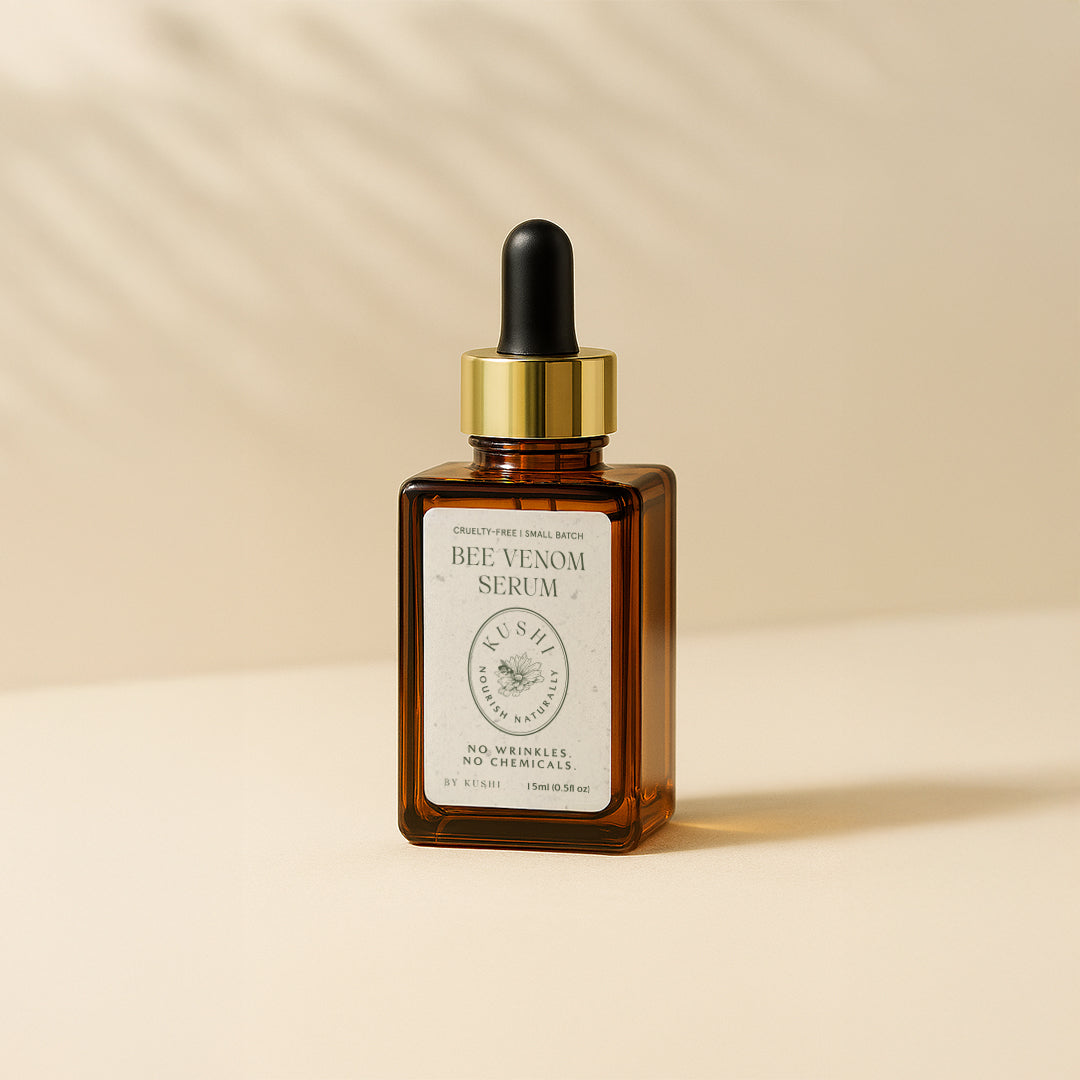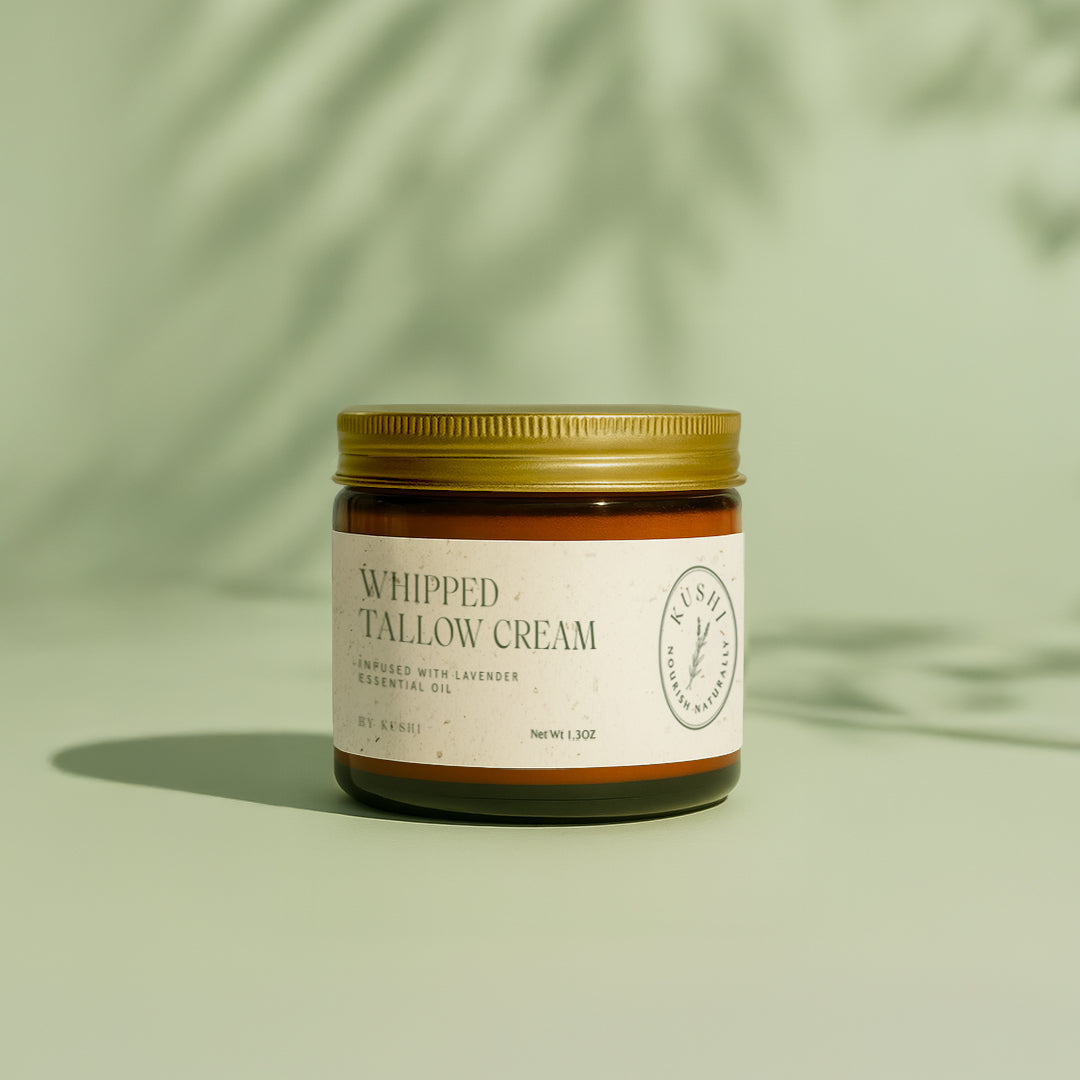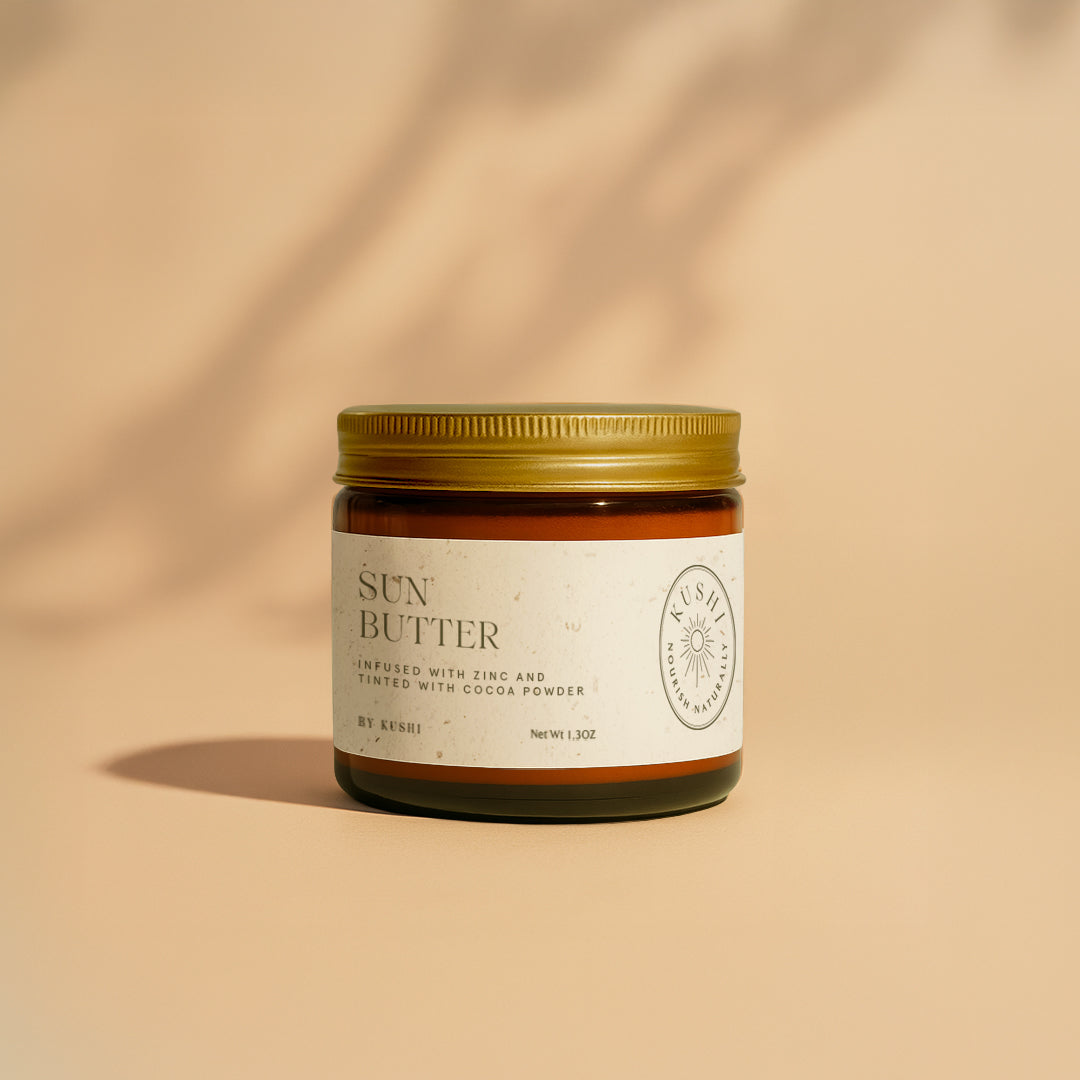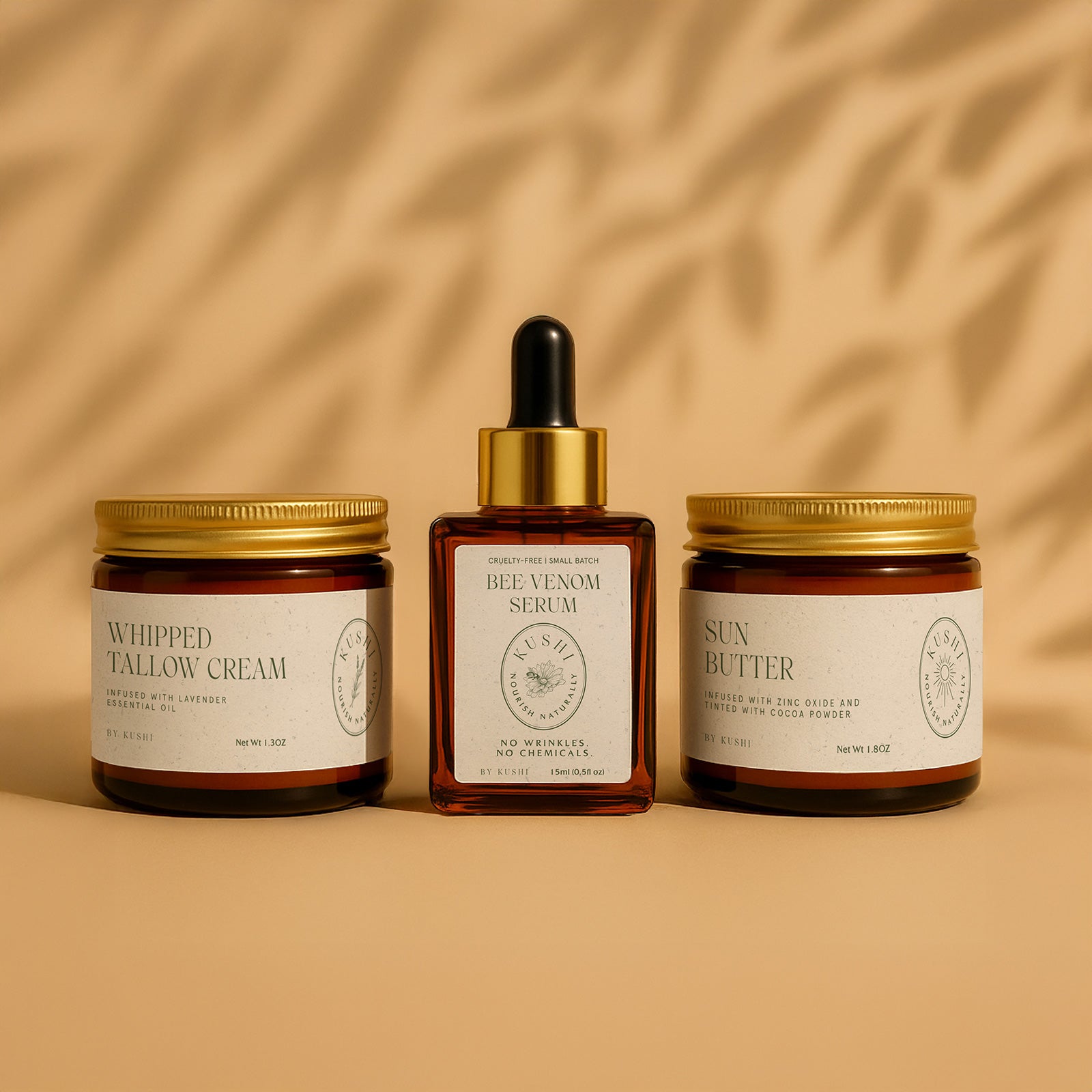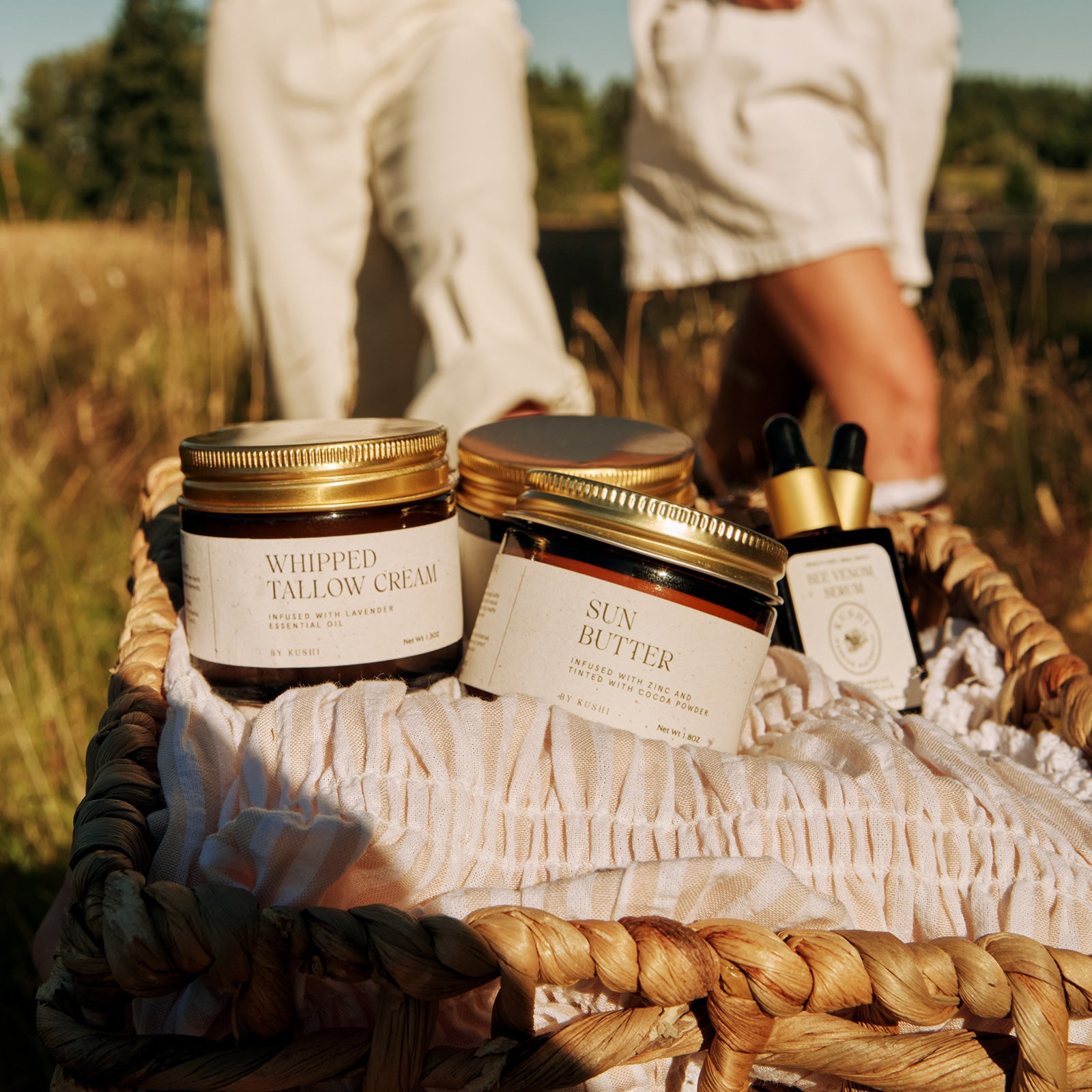Sunscreen Alternatives
Let’s talk about sunscreen. Or more specifically: why some of us are ready to move beyond the traditional white-slicked, lab-synthesized versions of it. The more you learn about what’s in conventional sun care, the harder it is to ignore. Chemicals that disrupt hormones. Residues that bleach coral reefs. Textures that feel more like obligation than care. And for sensitive skin, these formulas can often do more harm than good.
5.0 / 5.0
(5) 5 total reviews
Sun Butter
Sun Butter is a 2-in-1 tallow-based moisturizer and mineral sun balm that delivers clean, effective UVA + UVB protection using non-nano zinc oxide. Made with just five nutrient-rich ingredients—including grass-fed tallow, mango butter, and cocoa powder—it hydrates, nourishes, and defends without synthetic chemicals. Ideal for daily use and sensitive skin, it’s a safe, reef-friendly alternative to conventional sunscreen.
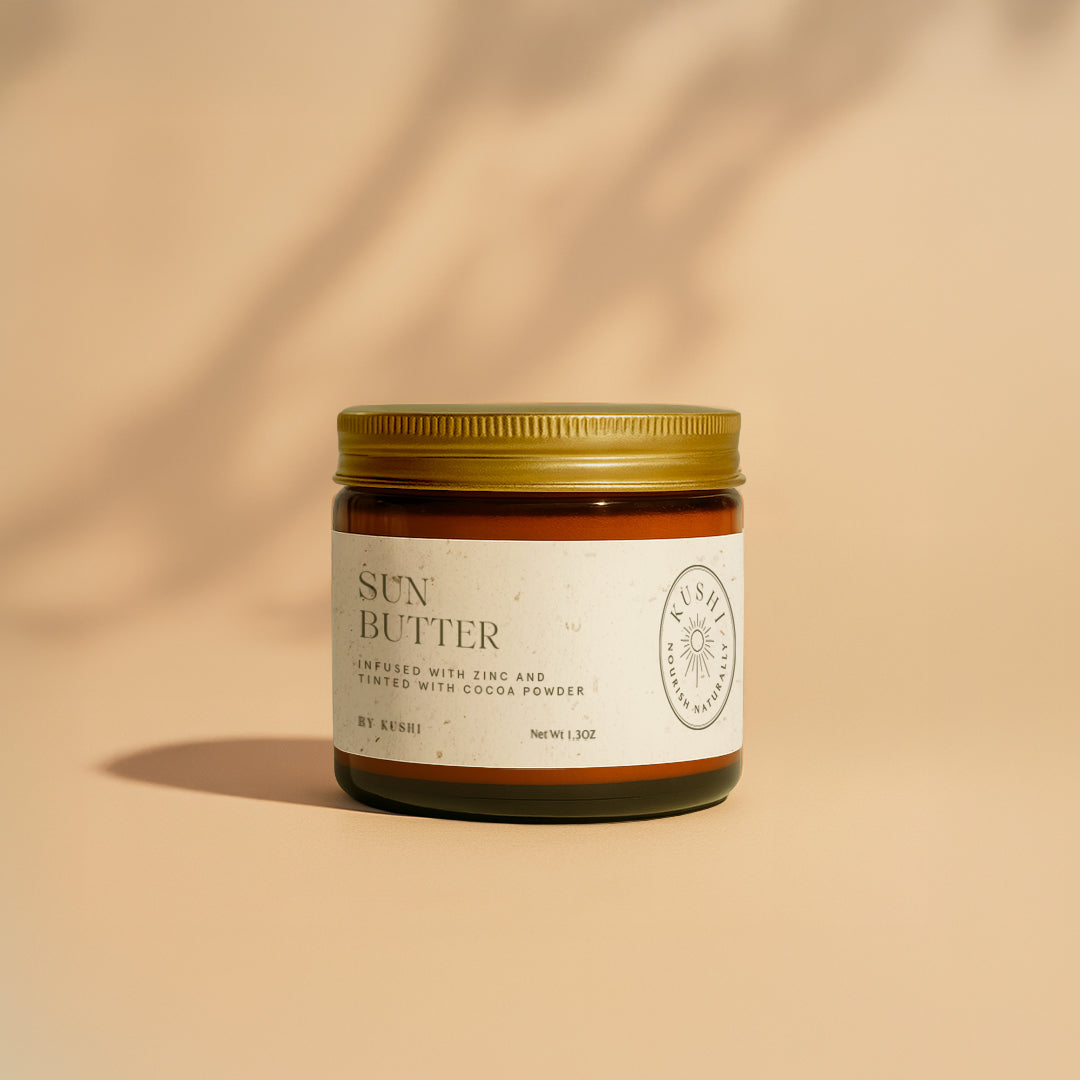
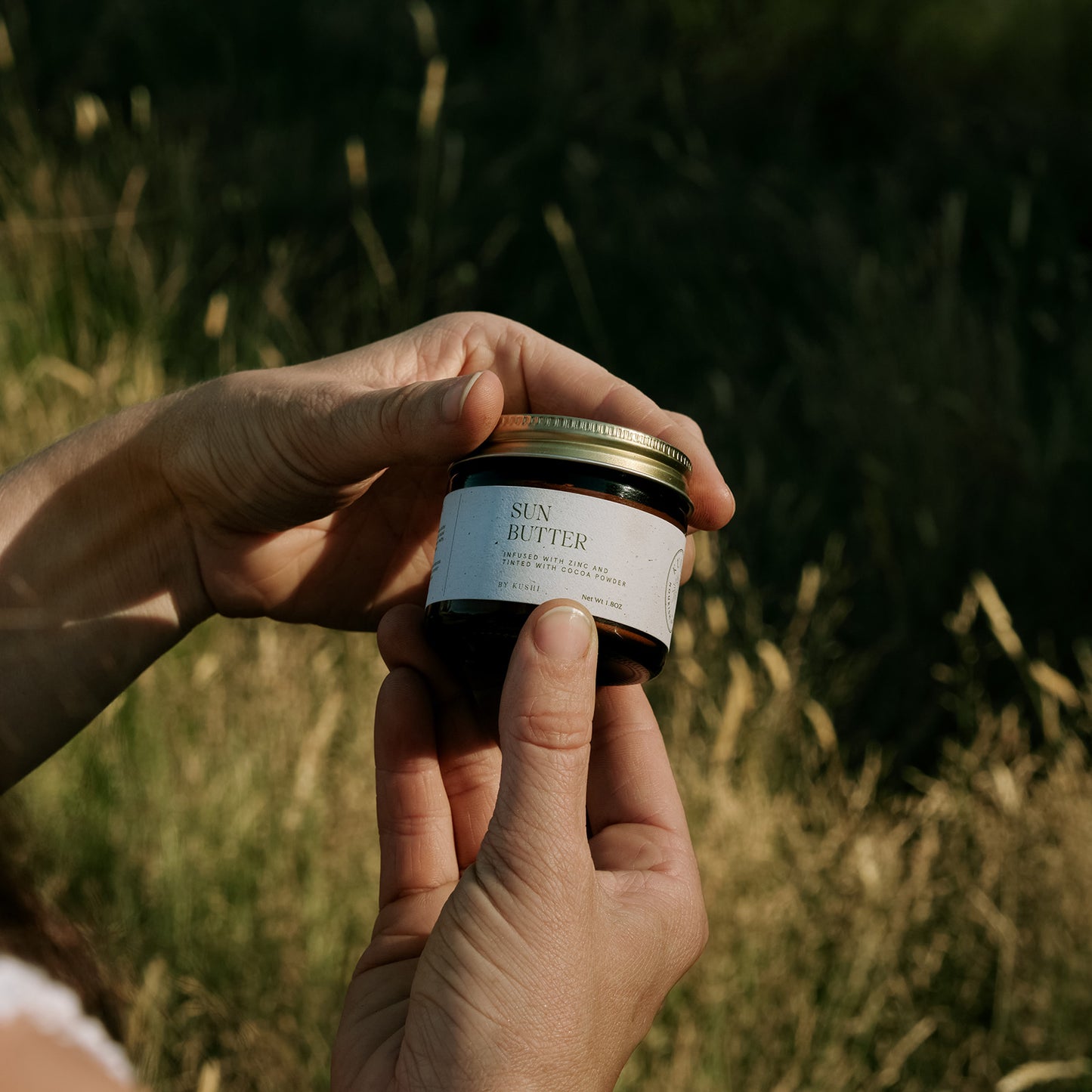
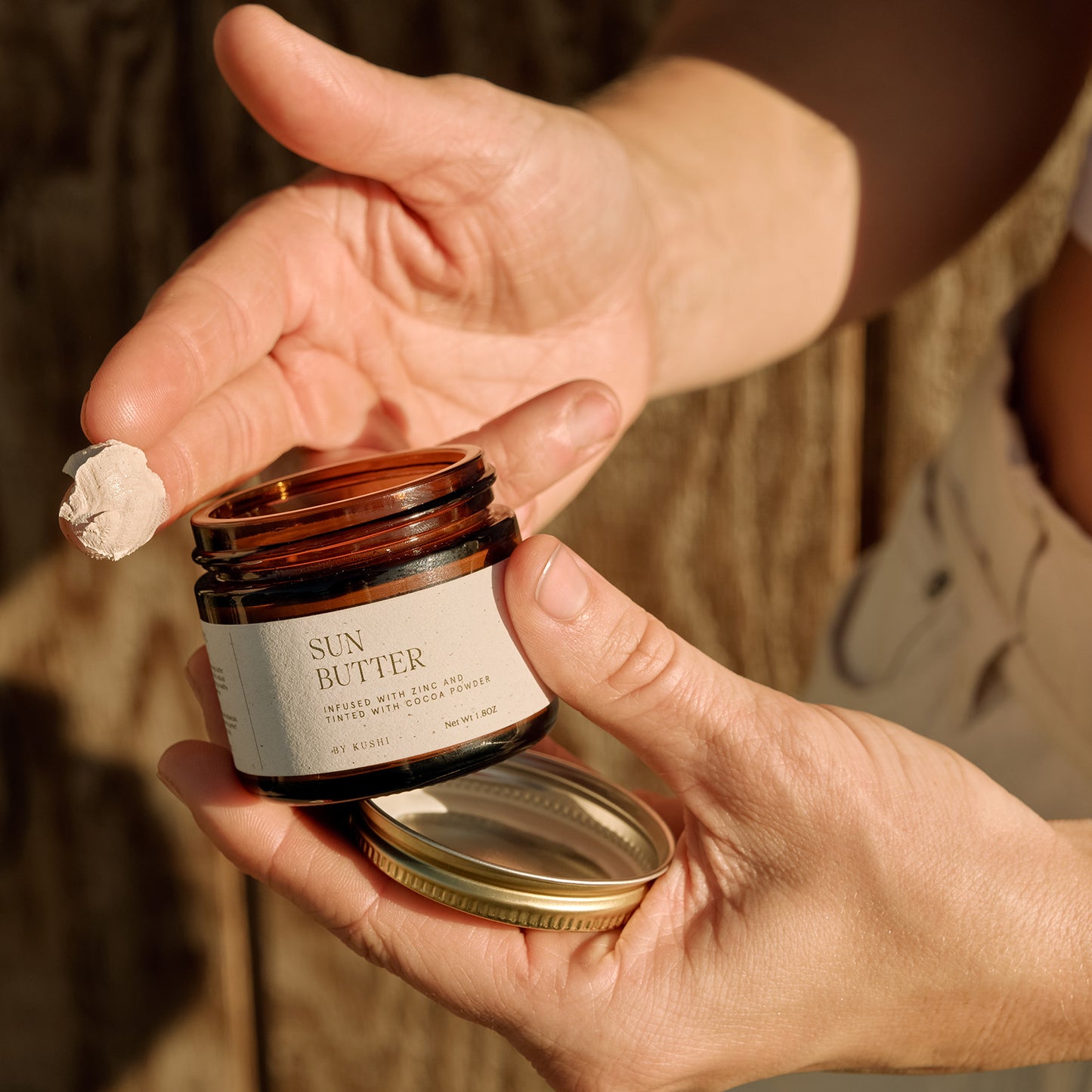
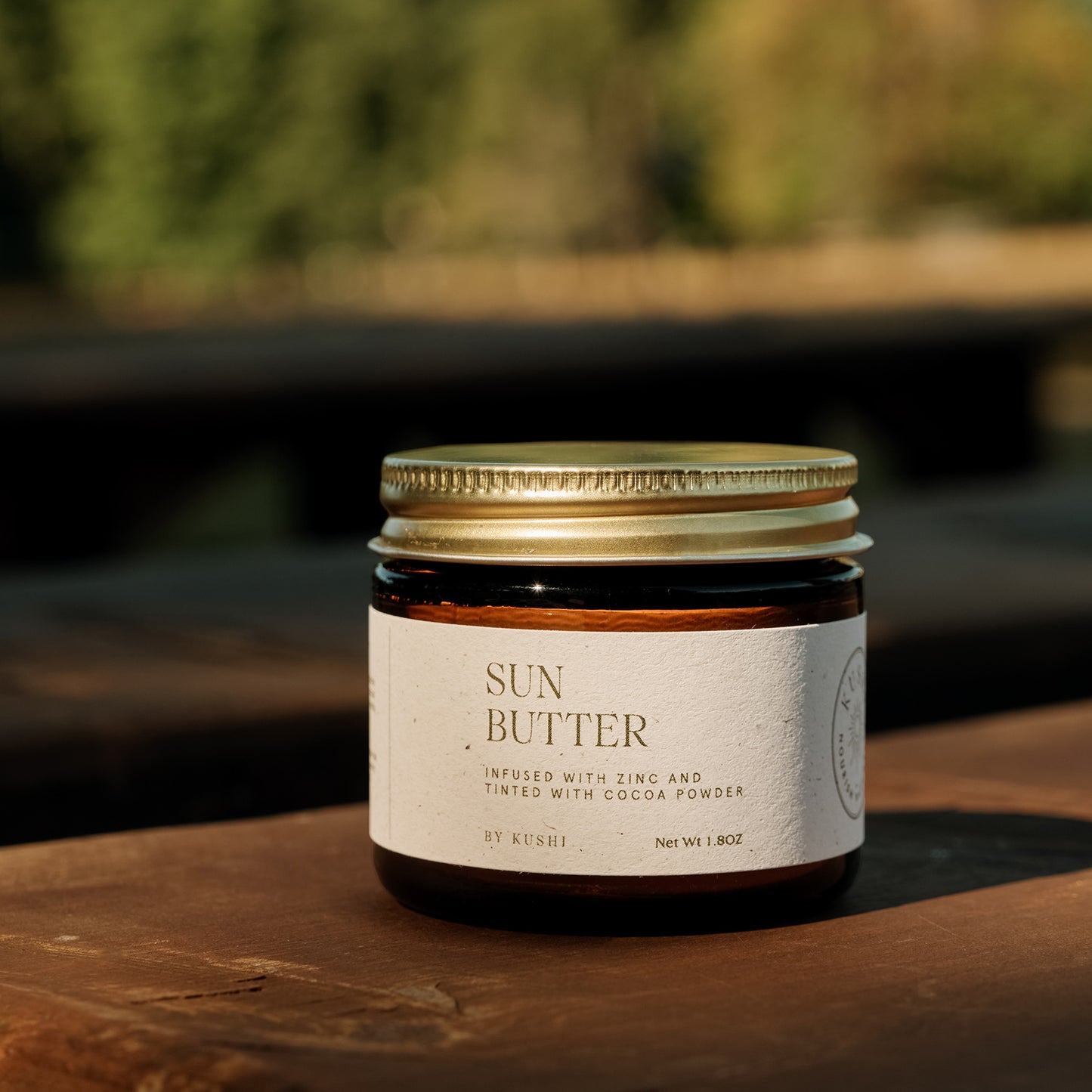
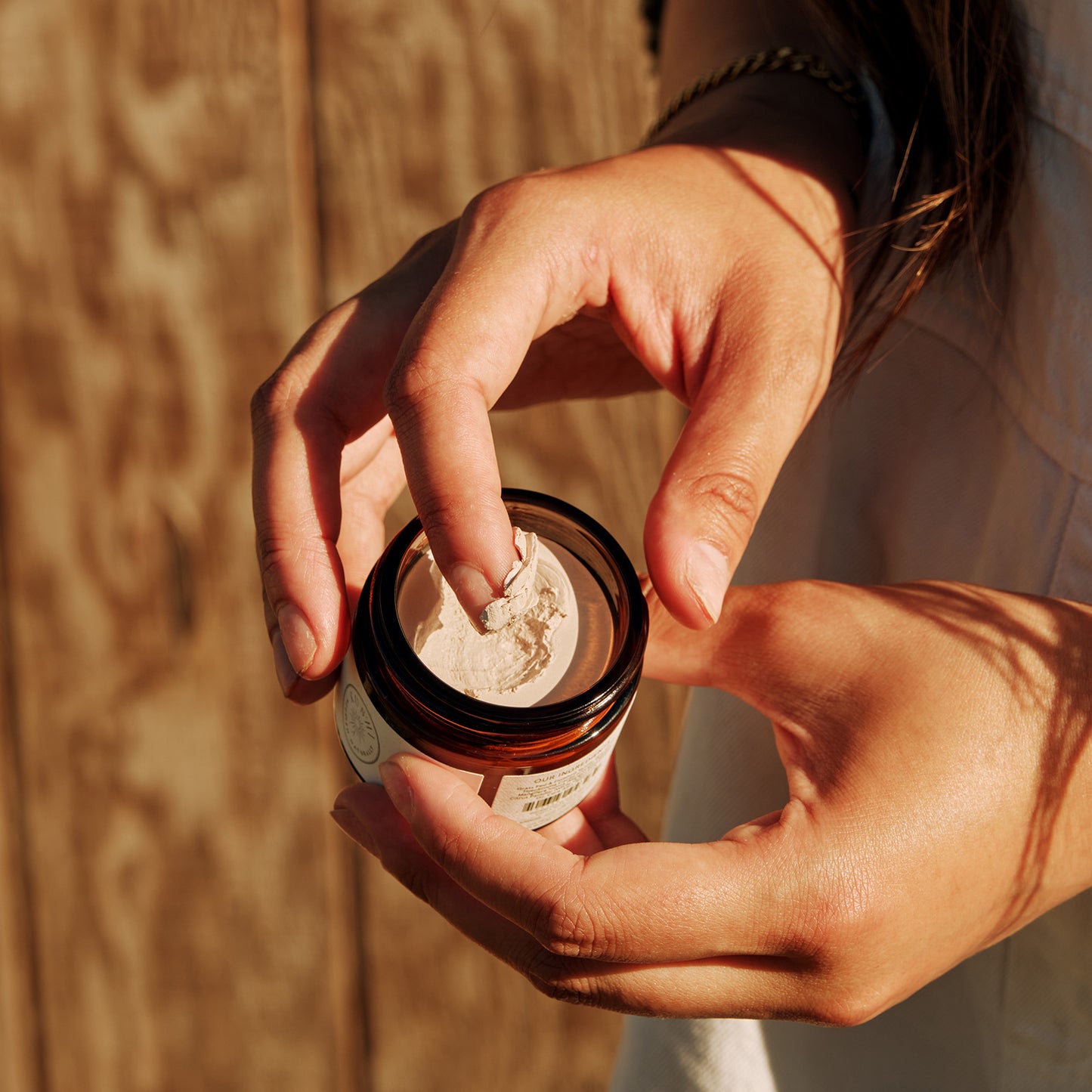
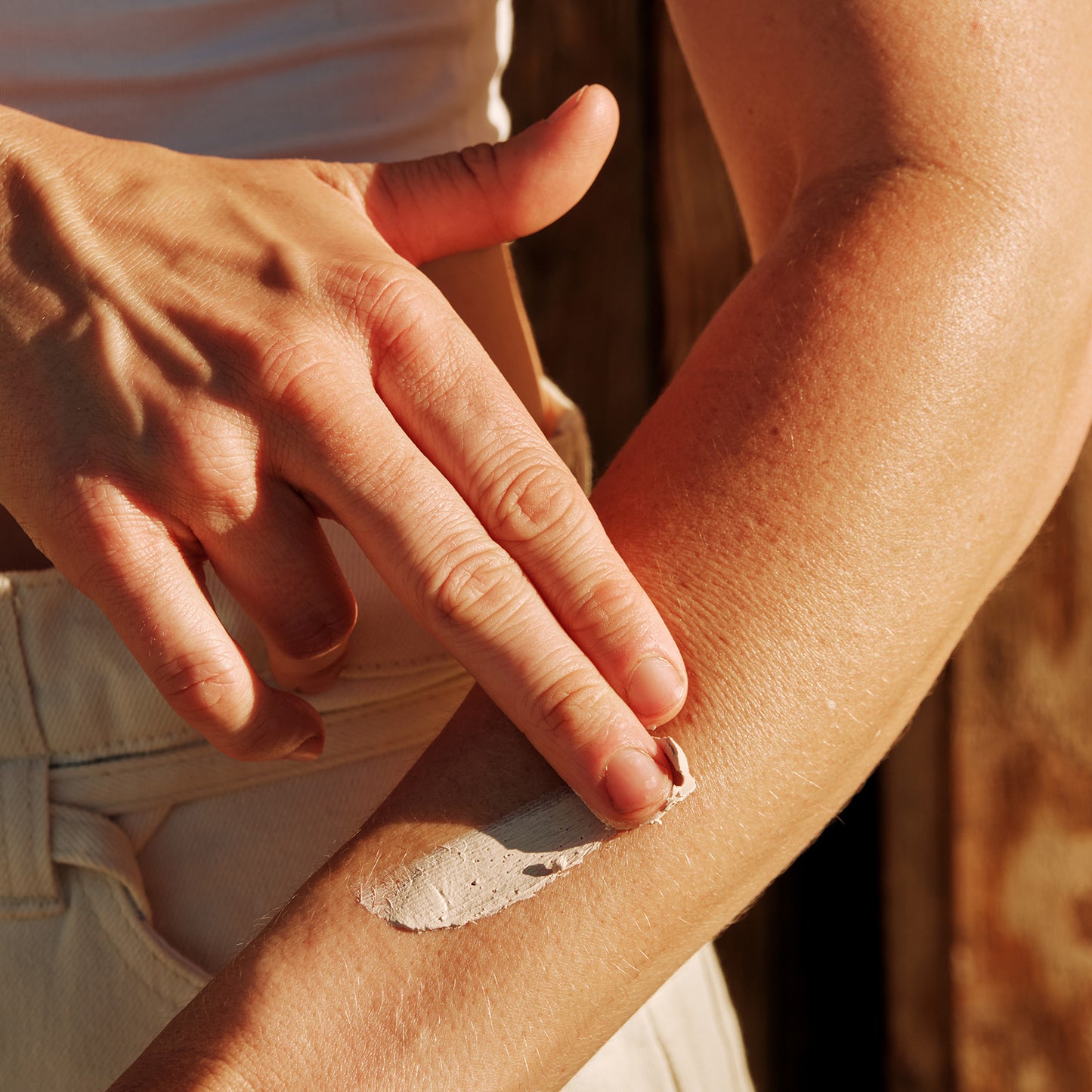

Understanding Sunscreen Alternatives
Sunscreen alternatives aren’t about skipping protection, they’re about rethinking what protection means. At Kushi, we’ve seen that true skincare goes beyond shielding. It’s about nourishment, intention, and staying connected to what your skin is actually asking for.
Conventional sunscreens often do one thing: block UV rays. But what if your sun care could do more, like soothe, hydrate, restore, and support your skin’s natural defenses while still giving you peace of mind under the sun? That’s where alternatives come in.
We're talking about plant-powered butters, mineral-rich clays, botanical oils, and natural antioxidants, each one selected not just for how it protects, but how it interacts with your skin barrier. Many of these ingredients have been used across cultures for generations, long before SPF became a label.
These options don’t rely on synthetic filters or heavy formulations. Instead, they create a physical barrier on the skin or deliver UV-resilient compounds in ways your body can actually recognize. And unlike many traditional sunscreens, they tend to be reef-safe, biodegradable, and kinder to sensitive skin.
This philosophy is what led us to create Sun Butter, our signature blend of nourishing, mineral-based ingredients that support your skin through every sun-soaked moment. It's sun care that doesn't compromise: not on texture, not on ethics, not on results.
You don't have to choose between being sun-safe and ingredient-conscious. Alternatives exist, and they’re worth exploring.
Why Look For Sunscreen Alternatives?
For many, the journey toward sunscreen alternatives starts with a simple question: What’s actually in this stuff I’m putting on my skin every day?
There’s growing awareness around the chemicals commonly found in traditional sunscreens, like oxybenzone, avobenzone, and octinoxate. These compounds may absorb UV rays effectively, but they can also absorb into the bloodstream, disrupt hormones, and trigger skin irritation for sensitive users. Some have even been banned in regions like Hawaii due to their impact on coral reefs.
Beyond the ingredient list, there’s the texture, the feel, and the residue that some chemical sunscreens leave behind. Chalky finishes, clogged pores, and that unmistakable “sunscreen smell” can turn what should be a daily ritual into something you dread.
At Kushi, we’ve always believed that sun care shouldn’t come at the expense of your skin’s comfort, or the planet’s health. We wanted something different. Something made with fewer ingredients, all chosen with care. Something that feels like skincare, not just sun protection.
That’s why exploring alternatives matters. Because the more we understand what we’re putting on our skin, the more empowered we are to choose better, for our health, our ecosystems, and our everyday experience in the sun.
The Problem With Conventional Sunscreens
Most people reach for sunscreen thinking they’re doing the right thing, and on the surface, they are. But underneath that promise of protection lies a cocktail of ingredients that deserve a closer look.
Many mainstream sunscreens rely on chemical UV filters like oxybenzone, homosalate, or octinoxate. These ingredients are designed to absorb UV rays before they penetrate the skin. But several of them have raised red flags in recent studies, both for human health and environmental safety. Some have been linked to hormonal disruption, while others are known to linger in the body long after application.
Then there’s the issue of coral reefs and marine life. When these chemical filters wash off in the ocean, they don’t just disappear. They can damage delicate ecosystems, interfere with marine reproduction, and even contribute to coral bleaching. That’s why certain destinations have banned these ingredients entirely.
For those with sensitive skin, the problems can feel even more immediate, breakouts, burning, and inflammation are common complaints. And ironically, some sunscreens meant to protect can actually degrade in the sun, forming free radicals that contribute to aging and oxidative stress.
We’ve seen enough to know this isn’t the kind of “protection” we want to offer.
At Kushi, our view is simple: the fewer questionable ingredients between you and the sun, the better. That's why we formulated Sun Butter using a base of mineral protection, plant-based oils, and nourishing butters, no synthetics, no harsh chemicals, and no compromise on what your skin actually needs.
Let’s Talk About Sun Butter
We didn’t want to make just another sunscreen. We wanted something that felt like a daily ritual, something your skin would actually crave. That’s how Sun Butter was born: our plant-based, mineral-powered balm designed to nourish and protect in one effortless sweep.
At the core is non-nano zinc oxide, chosen for its broad-spectrum physical protection that reflects UV rays without ever sinking into your bloodstream. But that’s just the beginning. We surrounded it with a cushion of rich shea butter, sun-resilient red raspberry seed oil, creamy coconut oil, and silky candelilla wax. Together, they form a buttery-soft blend that glides on smoothly, melts into your skin, and leaves a natural finish, no white cast, no sticky residue, no harsh smells.
This isn’t your average chalky SPF. It’s protection that feels like skincare. Every ingredient was chosen not just for what it blocks, but for what it brings, calming inflammation, restoring moisture, and supporting your skin’s natural resilience in the face of sun, wind, and salt.
Sun Butter is packaged in a sleek, travel-ready tin that fits into your bag, your beach tote, or even your back pocket. Whether you're hiking, surfing, gardening, or just walking the dog, it’s designed to be there with you, always ready, always gentle.
Skin care and sun care shouldn’t be two separate steps. With Sun Butter, they’re one and the same.
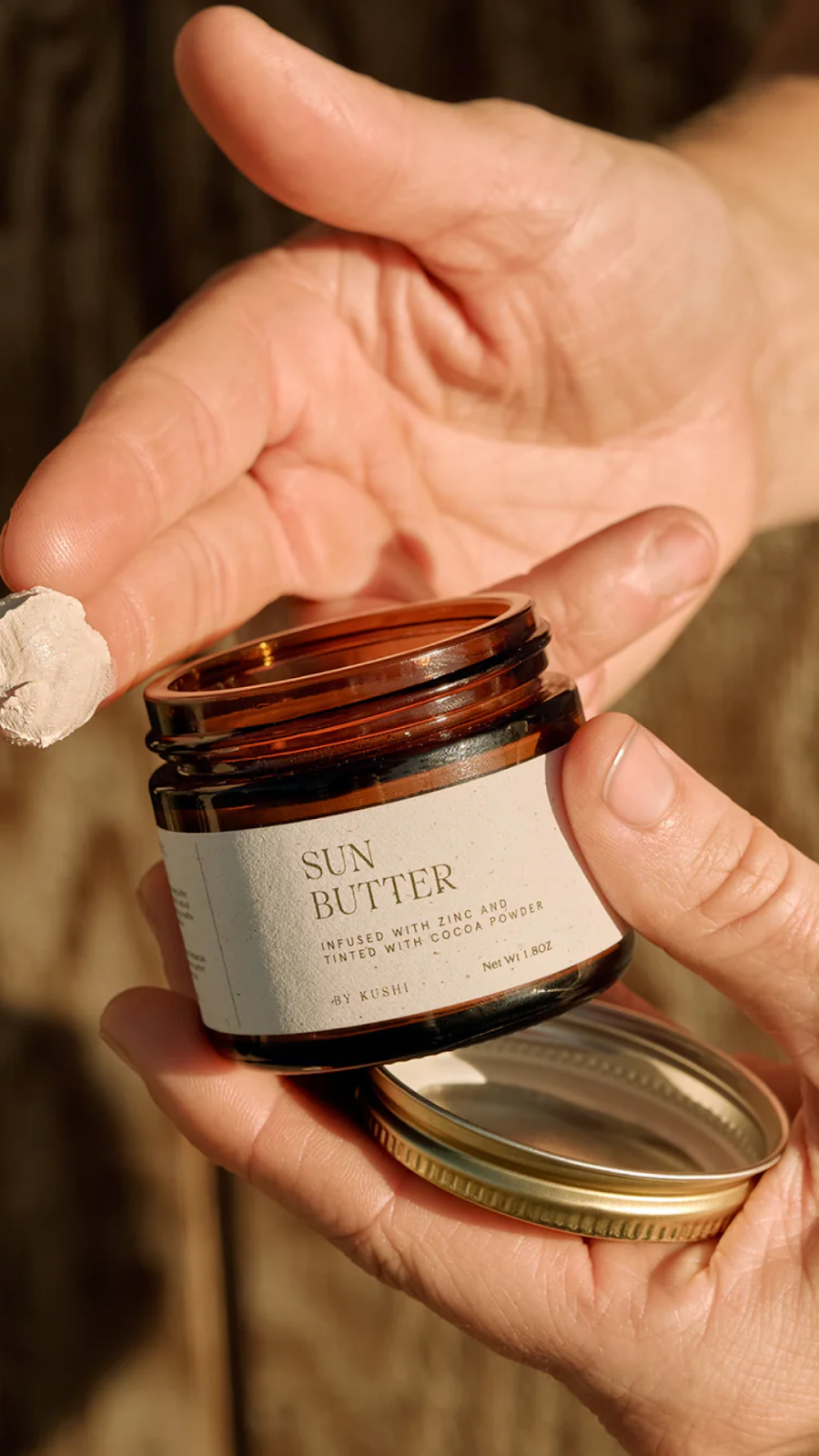
Natural Ingredients That Offer Sun Protection
Nature offers more than enough when it comes to daily skin support. These ingredients don’t just sit on your skin, they interact with it, nourish it, and offer a more intuitive way to stay protected outdoors.
Zinc Oxide (Non-Nano)
Zinc oxide is a mineral filter that provides broad-spectrum protection by reflecting and scattering UVA and UVB rays. We use a non-nano version in our Sun Butter, so it stays on the surface of your skin, never absorbed, always reef-safe.
Shea Butter
More than a moisturizer, shea butter delivers essential fatty acids that help reinforce the skin’s barrier. It also offers mild natural sun protection and soothes sun-exposed or dry skin with its deeply nourishing texture.
Red Raspberry Seed Oil
This antioxidant-rich oil is known for its impressive UV resistance and potential to protect against both UVA and UVB rays. It’s packed with vitamin E and polyphenols, which help support the skin’s repair process after sun exposure.
Coconut Oil
Coconut oil contains small amounts of natural SPF and works beautifully as a base oil. Its anti-inflammatory and antimicrobial properties help calm the skin while supporting hydration, especially after time in the sun.
Candelilla Wax
A vegan alternative to beeswax, candelilla wax gives our formula its silky glide and water-resistant finish. It helps lock in moisture and creates a light, breathable barrier without clogging pores or feeling heavy.
How To Use Sun Butter Daily
Sun Butter is designed to simplify your routine, not complicate it. Here's how to get the most out of it, every day.
Step 1: Scoop A Small Amount
Use clean fingers to scoop out a pea-sized amount to start. The formula is rich and concentrated, so you won’t need much.
Step 2: Warm Between Fingers
Rub the product between your fingertips for a few seconds. This helps soften the balm, making it even easier to apply and blend.
Step 3: Apply To Exposed Skin
Gently press and glide the butter onto areas exposed to the sun, face, neck, chest, shoulders, arms, or anywhere else that needs coverage. Take your time and let it melt in naturally.
Step 4: Blend Until Sheer
Massage in with circular motions until the product blends evenly into the skin. It should leave a smooth, dewy finish without a white cast or stickiness.
Step 5: Reapply As Needed
For extended outdoor time, reapply every 2–3 hours, especially after swimming or sweating. The compact tin makes it easy to take with you on the go.
Bonus Tip:
Don’t forget the easy-to-miss areas: tops of ears, back of the neck, hairline, and the backs of your hands. These spots are often forgotten but still vulnerable to sun exposure.
Other Holistic Ways To Support Skin In The Sun
Sunscreen, or Sun Butter, is just one part of the equation. Supporting your skin holistically means thinking beyond the surface. Here’s how we approach full-spectrum skin wellness at Kushi.
Cover Up With Intention
Think of clothing as your skin’s first line of defense. Lightweight, breathable fabrics like organic cotton or linen allow your body to stay cool while shielding it from direct sun. A wide-brimmed hat, a flowy long-sleeve, or a light scarf around your neck can make a noticeable difference, without sacrificing comfort or style. Protection doesn’t have to feel restrictive; it can feel beautiful.
Eat For Skin Resilience
Healthy skin begins in the gut. Antioxidant-rich foods, like blueberries, leafy greens, turmeric, tomatoes, and nuts, help combat free radicals caused by sun exposure. Omega-3 fatty acids, found in flaxseeds or wild-caught fish, support the skin’s elasticity and repair response. The more nutrient-dense your plate, the more resilient your skin becomes.
Time Your Sun Exposure
The sun has rhythm, and so should your time in it. Aim to soak up early morning or late afternoon rays when the sun is gentler and UV intensity is lower. Avoiding peak hours (typically 10am–4pm) helps minimize unnecessary stress on your skin, especially over long periods. You don’t need to avoid the sun, just meet it on your terms.
Hydrate, Inside And Out
Your skin loses moisture faster when it’s exposed to heat, saltwater, and sweat. Keep your body replenished by drinking plenty of water throughout the day. On the outside, use products that both hydrate and seal, like Sun Butter, which delivers skin-soothing moisture with the added bonus of natural protection. Hydration is your skin’s language of love.
Choosing What Feels Right For Your Skin
There’s no universal rule for how to protect your skin, only what feels honest, aligned, and nourishing to you. Skin isn’t just a surface; it’s a communicator, a boundary, a mirror of how you live. And sun care should honor that.
Maybe you're someone who loves soaking in the morning light barefoot on the grass. Maybe you hike, swim, or spend weekends in the garden. Maybe you just want something gentle enough to wear on your face every day without a second thought. Wherever you are in your relationship with the sun, the most important choice is a conscious one.
That’s why we made Sun Butter, to give your skin a product that protects without muting, that supports without smothering. It’s not built to change your skin; it’s built to listen to it. Rich, mineral-based, and grounded in whole, recognizable ingredients, it’s there for your rituals, however simple or wild they may be.
Choosing sunscreen alternatives isn’t about stepping away from something. It’s about stepping into something deeper: a slower, softer way of caring for your body, your environment, and your presence in the sun.
Listen to your skin. Follow what feels good. And give it what it’s quietly been asking for all along.
Read also:
Sources:
- Ácsová, A., Hojerová, J., Janotková, L., Bendová, H., Jedličková, L., Hamranová, V., & Martiniaková, S. (2021). The real UVB photoprotective efficacy of vegetable oils: in vitro and in vivo studies. Photochemical & Photobiological Sciences, 20(1), 139–151. https://doi.org/10.1007/s43630-020-00009-3
- Schneider, S. L., & Lim, H. W. (2018). A Review of Inorganic UV Filters Zinc Oxide and Titanium Dioxide. Photodermatology, Photoimmunology & Photomedicine, 35(6), 442–446. https://doi.org/10.1111/phpp.12439
- Pereira, M. D., Mota, M. D., & Paula Pereira, N. de. (2025). Photoprotective efficacy of seed oils from fruits of Brazilian flora: a scoping review. Photochemical & Photobiological Sciences : Official Journal of the European Photochemistry Association and the European Society for Photobiology, 24(7), 1195–1215. https://doi.org/10.1007/s43630-025-00760-5
- Adler, B. L., & DeLeo, V. A. (2020). Sunscreen Safety: A Review of Recent Studies on Humans and the Environment. Current Dermatology Reports, 9. https://doi.org/10.1007/s13671-020-00284-4
Frequently Asked Questions
What are sunscreen alternatives exactly?
Sunscreen alternatives are products or practices that offer sun protection without relying on conventional chemical SPF formulas. They often use mineral blockers or plant-based ingredients to provide defense while supporting skin health naturally.
Can sunscreen alternatives really protect against sunburn?
Some ingredients like non-nano zinc oxide and red raspberry seed oil offer measurable protection, but no natural method is 100% foolproof. Combining alternatives with smart habits, like wearing protective clothing and avoiding peak sun, is key.
Is natural sun protection enough for extended sun exposure?
For longer periods in strong sun, layering is important. Natural products can be effective, but they may need to be reapplied more often and used with shade or clothing.
Do sunscreen alternatives expire like regular SPF products?
Yes. Natural products often have shorter shelf lives due to the lack of synthetic preservatives. Always check the expiration date and look for changes in texture or scent.
Are sunscreen alternatives suitable for children or babies?
Mineral-based options like zinc oxide are generally safe for babies and children. Still, it’s best to patch test and consult a pediatrician if there’s any concern.
Can I use makeup with sunscreen alternatives?
Yes. Many natural sun butters and mineral sunscreens work well under makeup. Look for lightweight formulations that won’t cause pilling or excess shine.
